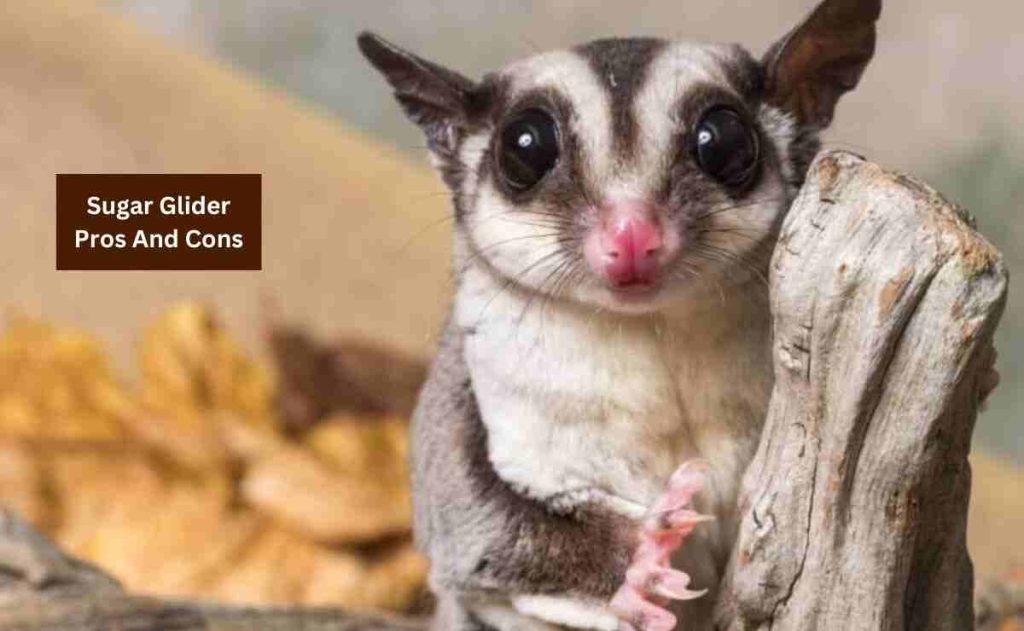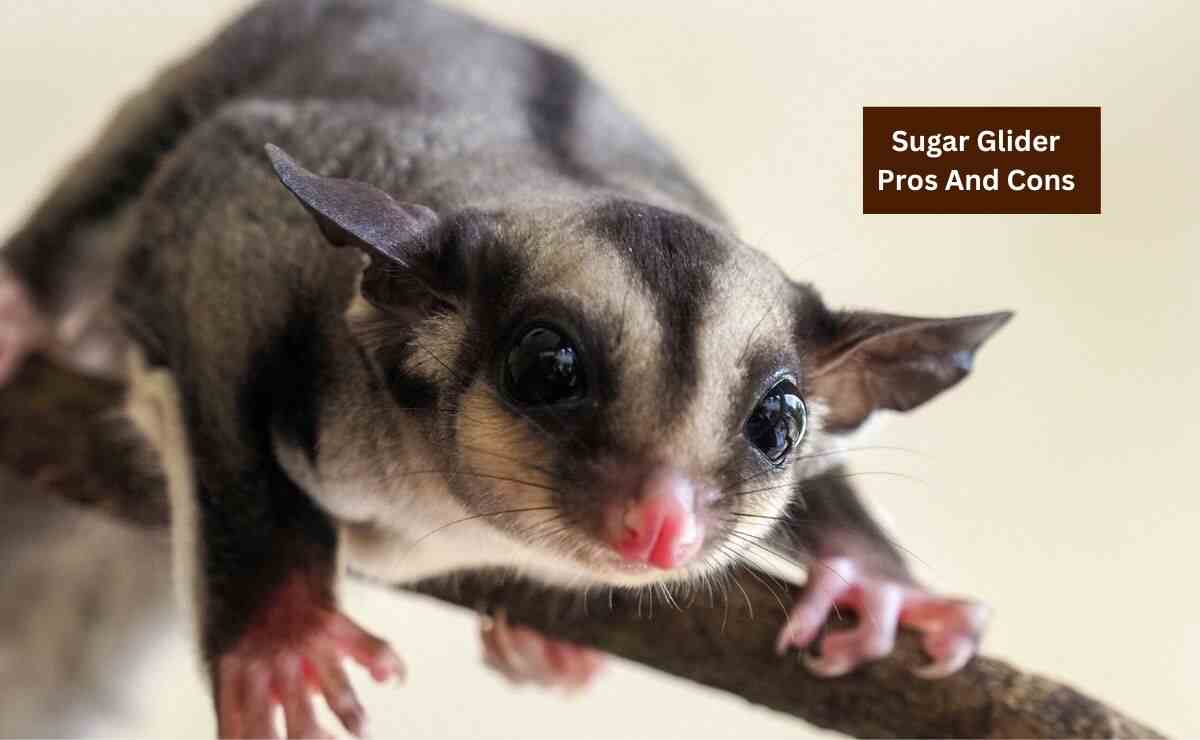Sugar gliders are one of the popular pets as they are so adorable and sociable. But whenever you consider adding a sugar glider to your household as a pet, you have to weigh the pros and cons.
Sugar gliders have become increasingly adopted as pets due to their adorable appearance and unique behaviors. Still, owning a sugar glider requires a significant commitment and you require an understanding of their needs. So here you can have a detailed view of sugar glider pros and cons.
About Sugar Gliders
Sugar gliders are small, nocturnal animals that are native to Australia, New Guinea, and Indonesia. They look like squirrels. Their fur color is gray with black markings. Many mistake them for rodents, but they are actually small marsupials, sharing a familial connection with kangaroos and koala bears.
The intriguing name ‘sugar glider’ stems from their fondness for sweet foods, particularly fruits. Moreover, these little marsupials have a remarkable feature — a gliding membrane that extends from their wrist to their ankle, enabling them to gracefully glide between trees.
These pocket-sized companions are very intelligent. They can be trained to perform tricks and respond to calls, showcasing their ability to form a bond with you. When provided with the correct care, sugar gliders boast an impressive lifespan, averaging between 12 to 15 years.
Sugar Glider Pros And Cons

If you’re going to adopt sugar gliders, you must consider these pros and cons. So here they are:
Pros Of Sugar Gliders
1. Extended Lifespan
Sugar gliders are small marsupials with a remarkable lifespan. Unlike many pocket pets that typically live for a couple of years, these pets can spend up to 15 years with you with proper care. So they offer a long-term companionship comparable to that of dogs and cats.
2. High Activity Levels
Sugar gliders are highly active animals. If they don’t get enough mental stimulation, they get bored. So you will get endless moments of joy with this little companion.
The sheer joy of having a sugar glider around makes the effort worthwhile. Their adorable nature and playful antics contribute to a fun and rewarding experience, especially when you invest time in the bonding process.
4. Playful and Loyal
Sugar gliders not only love to play but also form a deep bond once you complete the bonding process. Their loyalty is evident as they seek attention throughout the day. For those living alone, having a sugar glider as a companion can be particularly fulfilling.
When properly socialized, sugar gliders can form a strong connection with their human caretakers. They enjoy being held and can become quite affectionate.
5. Limited Biting Incidents
While sugar gliders have natural predator instincts, biting issues can be a concern. Though incidents of biting are rare and often stem from fear or feeling threatened. However, if they bite you, their teeth are not intended to be like a downward sheering action. It’s like a firm pinch.
To avoid any bite from your pet is consistent bonding and interaction, fostering a strong sense of loyalty between the pet and its owner. When you spend enough time with your gliders enough time, you won’t face this issue.
6. Clean and Predictable
Sugar gliders exhibit a remarkable level of cleanliness and predictability. When carrying a sugar glider around during the day, their body language becomes a clear indicator of their needs.
As responsible owners, you’ll quickly learn to recognize the signs, allowing you to put them down at the right moment, thus avoiding any accidents. This intuitive communication between pet and owner fosters a harmonious relationship, enhancing the overall pet-keeping experience.
Cons Of Sugar Glider
1. Nocturnal Lifestyle
One significant consideration when welcoming a sugar glider into your home is its nocturnal nature. They are highly active at night and require a quiet, dark environment during the day for their sleep. This can be challenging for those who have a daytime work or school schedule and are unable to interact with them during their active hours.
2. Colony Dependency
Sugar gliders thrive on socialization due to their colony animal nature. Their family structure is reminiscent of other colony animals. While some families have successfully kept a single sugar glider, it is generally acknowledged that having two of these pocket pets is more advantageous. When left alone, a solitary sugar glider may exhibit signs of distress, such as over-grooming, refusal of food, or self-harm.
However, this social aspect comes with financial considerations. The average cost of a sugar glider as a joey, ranging from $200 to $500 at the age of 8-12 weeks, might pose a challenge for some families. Even if opting for an adult marsupial, the cost remains in the range of $100 to $150 per animal.
It’s important for prospective owners to factor in this expense, especially when considering the recommended practice of having at least two sugar gliders for their well-being.
3. Specific Nutritional Needs
Sugar gliders glide around the house like flying squirrels. Owners may notice their sugar gliders snitching such treats if left out. While these sugary delights might be enticing, relying solely on them can lead to nutritional imbalances and health issues.
It falls upon the owner to provide a well-rounded diet that meets the specific nutritional needs of sugar gliders. Without a proper staple diet, sugar gliders can face immediate health challenges, ranging from an increase in animal odor to more severe issues like paralysis of their hind legs.
Feeding healthy sugar gliders involves a monthly expense, estimated at around $10 per glider. This cost includes a carefully proportioned ratio of approximately 25% produce and the remaining portion as pellet food.
4. Specialized Veterinary Care
Sugar gliders require veterinary care from professionals familiar with exotic animals, which may be challenging to find in some areas. The absence of an experienced vet can leave owners in a vulnerable position during medical emergencies, potentially jeopardizing the life of the sugar glider.
Even when veterinary services are available, the cost for visits may be substantially higher than those for more conventional pets like dogs or cats.
5. Time-Consuming Bonding Process
Making a bond with sugar gliders is a time-consuming process that requires patience and consistency. Unlike the immediate affection often seen in dogs and some cats, sugar gliders are naturally leery of human beings due to their exotic nature.
This inherent wariness can lead to a prolonged bonding process, and owners should be prepared for the commitment it entails. Successfully completing the bonding cycle may take up to 12 months, and it is not uncommon for several weeks to pass before the sugar gliders are even willing to be touched.
6. Legal Restrictions
Owning a sugar glider falls under the jurisdiction of state and local regulations, and it’s imperative for prospective owners to thoroughly research and understand the legalities in their specific area.
Some areas like Hawaii, Alaska, and California, New York City, and Salt Lake City, impose restrictions on sugar glider ownership. However, the regulations may vary within the state, allowing ownership in other parts.
In some regions, owning a sugar glider may require obtaining a special permit. Additionally, certain areas may mandate purchasing the pet exclusively from a licensed breeder registered with the U.S. Department of Agriculture.
Are Sugar Gliders Good Pets?
Sugar gliders can make great pets for the right owner. However, they require a high level of care and attention, so it’s important to understand the responsibilities involved before deciding to get a sugar glider as a pet.
Sugar gliders are social animals and thrive in pairs or small groups, so it’s recommended to have at least two gliders to keep each other company. They require a large cage with plenty of space to climb and glide, as well as toys and enrichment activities to keep them engaged.
A diet consisting of a variety of fruits, vegetables, insects, and specially formulated glider food is necessary for their health and well-being.
While sugar gliders can bond with their owners and enjoy being handled, they are still wild animals and retain many of their natural behaviors. If you can maintain all these requirements for these sugar gliders, you can have them.
Before getting a sugar glider as a pet, it’s recommended to thoroughly research their care needs and consider if you have the time, resources, and commitment to provide a suitable environment for their well-being.
Final Words
Deciding to bring a sugar glider into your home is like juggling a mix of excitement and responsibilities. It’s a big decision, and before diving in, it’s essential to think about the good and not-so-easy parts.
In simple terms, having a sugar glider as a pet can be awesome, but it comes with some important things to consider. These little creatures need your time, attention, and a special kind of food to stay happy and healthy. It’s a commitment that requires effort.
If you’re ready for the challenge and willing to put in the work, owning a sugar glider can be a wonderful experience. They have the potential to be fantastic companions, bringing happiness and fun into your life.
